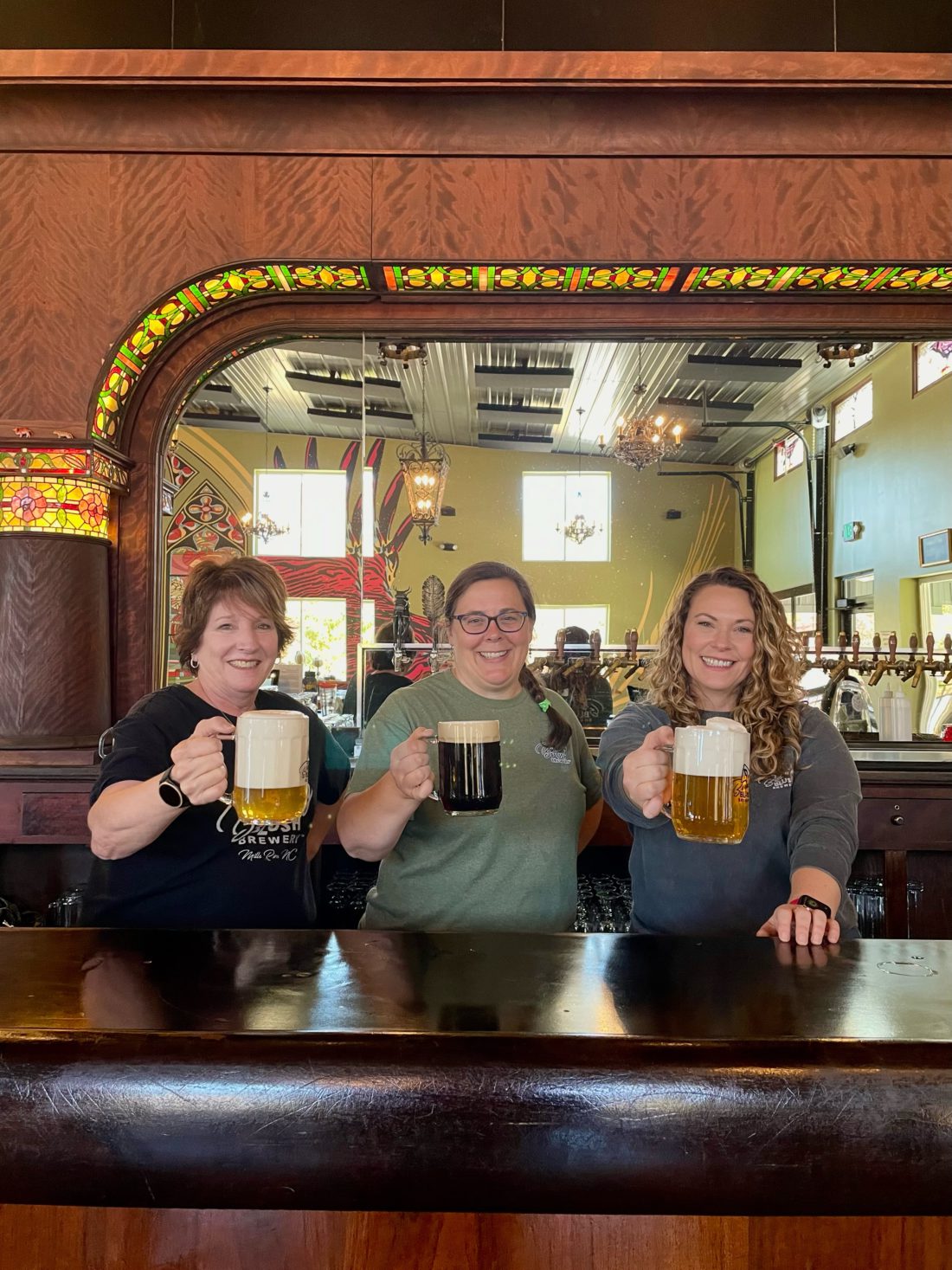Tired of the same old beer pours? Try some methods so old that they feel almost brand-new.
Side-pull faucets allow for multiple styles of serving brews that place an emphasis on foam and yield a notably creamier taste. While it’s tough to pinpoint when the hardware was first developed, Vince Tursi, head brewer and co-founder of DSSOLVR, notes that beer drinkers in today’s Czech Republic have been ordering these types of pours for hundreds of years. And these styles are becoming more widely available in taprooms throughout the Asheville area.
Instead of the simple open/close mechanics of a traditional beer tap, side-pull faucets have a ball valve that allows for different flow rates. The mechanism pushes the beer through a mesh or stainless steel screen that’s composed of hundreds of tiny openings, resulting in an increased amount of carbon dioxide breakout and foam. While fully opening the valve lets the beer move through freely, variations produce markedly different results.
“If you just barely crack it, you still have a bunch of restriction on the back end, which is then limiting flow, which then causes more breakouts and you literally just get foam,” Tursi says.
As soon as that breakout recovers, however, Tursi notes that you’re left with “superclean, crisp beer” — just like Czech drinkers have been enjoying for years.
By offering these alternative pours, brewers such as Tursi and Andrew Zinn, co-owner of Leveller Brewing Co. in Weaverville, stand out in an increasingly competitive industry where craft beverage quality continues to rise.
“You can get 80%-90% of the way [to a great beer experience] on the beer itself, but that last little bit is the part that matters the most,” Zinn says. Pouring a beer the right way and “serving it through proper equipment,” he notes, is essential to finishing the job.
The three pours
In keeping with tradition, Leveller and DSSOLVR typically serve pilsners and other lagers on their side-pull faucets. But since opening Burning Blush Brewery in Mills River in 2019, head brewer Whit Lanning has gone from having two side-pull faucets to featuring them on all 12 taps. Along with providing a quality regular pour, the equipment gives his bartenders more range, depending on the beer, as well as each customer’s preference.
“Each different type of pour is meant for the session that you’re drinking it on,” Lanning says. “We typically do a na dvakrat.”
Also known as a “crisp” pour, this method involves pouring in beer first and finishing with foam. Lanning notes that this approach produces an oxidation barrier and allows the beer to stay crisper longer. It’s therefore better for longer sits, particularly while eating, because the beer stays carbonated for a greater amount of time.
Imbibers can also request the hladinka or “smooth” pour, which involves an initial layer of foam on the bottom of the glass, followed by beer. The resulting pour is 20%-25% foam and, since it lacks the oxidation barrier, is better suited for more immediate drinking.

But gaining popularity is the mliko or “milk” pour, which is composed almost entirely of foam.
“It’s called a ‘milk pour’ because people can’t pronounce ‘mliko,’” Tursi says with a laugh.
He adds that a mliko pour will settle into half the volume of its glass if left undisturbed. But it’s intended for immediate consumption, similar to a shot, and has therefore caught on among certain beer drinkers.
Zinn became interested in the pour while visiting the Czech Republic and has advertised it on Leveller’s menu since opening the taproom. While overseas, he was informed that tourists are the primarily consumers of mliko, and though he’s an unapologetic fan of the style, it’s likewise been visitors to Weaverville who’ve expressed the most interest.
“We had some people here from New Jersey a couple weekends ago, and they asked, ‘Do you do milk tubes?’ Apparently people are calling them milk tubes up there,” Zinn says. “I’m not gonna call them that. I’m willing to mispronounce the Czech word.”
Niche market
In addition to Burning Blush, DSSOLVR and Leveller, Zillicoah Beer Co. co-owner Jeremy Chassner says his brewery usually has three side-pull faucets in operation. And Andrew Ross, co-owner of The Whale in West Asheville, currently has one such tap, on which the establishment serves its Haüs Pilz, which Fonta Flora Brewery makes specifically for the beer bar.
But if side-pull pours result in a superior beer experience, why don’t more taprooms offer them?
The costs of the equipment is a primary obstacle. Tursi says that the hardware was previously known as “beer faucets” until modern side-pull faucets were developed. And that the 1991 launch of LUKR CZ, which Tursi notes is the most famous manufacturer of the side-pull faucets, has helped make the hardware significantly more accessible.
Though prices of the Czech imports have come down in recent years, the LUKR faucets still run around $500 apiece and, according to Zinn, need a specific shank (i.e. the piece that goes through the wall that the faucet attaches to) for flow control.
Education is also a factor.
“Some people aren’t using it right. [DSSOLVR co-founder Mike Semenec and I have] been to places where you can tell that there’s no filter in place or the bartender isn’t doing it properly, and the it just doesn’t come out the same,” Tursi says. “It really is that slightly nuanced level of differentiation plus training that makes a world of difference. Anybody can open up a faucet, but to pull a proper side-pull is a little bit more difficult.”
Perhaps most prohibitive is customer perception. In addition to its side-pull faucet, Leveller features exclusively German faucets that are likewise designed to stick the nozzle into the beer glass.
“You get a beer anywhere in Europe, that’s how it’s done. You get a beer in the U.S. and you see it done like that and everyone’s like, ‘Ew, that’s disgusting. What are you doing? It’s so gross,’” Zinn says. “Why is it gross? The gross thing is that if people are not cleaning their taps enough to trust those [pours].”
Aiding that misconception are beer drinkers’ general opinions on foam. Many consumers think they’re being cheated out of a full pour if the beer doesn’t fill the pint glass to the brim. Local breweries try to get around the issue by serving the beverages in proper glassware.
Lanning notes that there’s nothing inherently wrong about most taprooms pouring beers in shaker pints — which, as their name suggests, are meant for shaking cocktails — but says that 18-ounce tankard glasses better support the foam atop the beer and result in a superior overall taste.
“We as a craft industry should be trying to teach consumers better about how important the foam is to making the beer taste great and finish on your palate right,” Lanning says. “I really do think it makes a difference in the flavor and the presentation, especially in those mugs. Seeing that three or four fingers of foam makes a huge difference, just to get different aromatics, different flavors and all that kind of stuff.”



Before you comment
The comments section is here to provide a platform for civil dialogue on the issues we face together as a local community. Xpress is committed to offering this platform for all voices, but when the tone of the discussion gets nasty or strays off topic, we believe many people choose not to participate. Xpress editors are determined to moderate comments to ensure a constructive interchange is maintained. All comments judged not to be in keeping with the spirit of civil discourse will be removed and repeat violators will be banned. See here for our terms of service. Thank you for being part of this effort to promote respectful discussion.